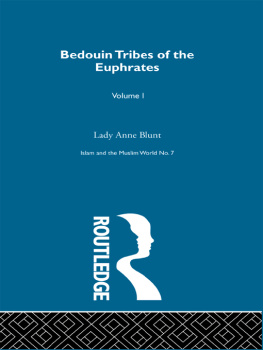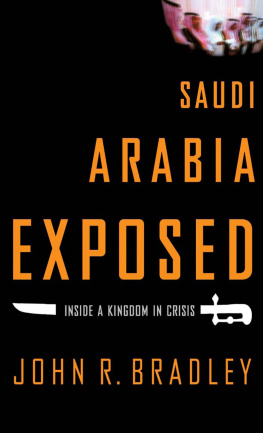ROUTLEDGE LIBRARY EDITIONS: SOCIETY OF THE MIDDLE EAST
Volume 5
BEDOUIN OF NORTHERN ARABIA
Bedouin of Northern Arabia
Traditions of the Al-hafir
Bruce Ingham
First published in 1986 by Kegan Paul International
This edition first published in 2016
by Routledge
2 Park Square, Milton Park, Abingdon, Oxon OX14 4RN
and by Routledge
711 Third Avenue, New York, NY 10017
Routledge is an imprint of the Taylor & Francis Group, an informa business
1986 Bruce Ingham
All rights reserved. No part of this book may be reprinted or reproduced or utilised in any form or by any electronic, mechanical, or other means, now known or hereafter invented, including photocopying and recording, or in any information storage or retrieval system, without permission in writing from the publishers.
Trademark notice : Product or corporate names may be trademarks or registered trademarks, and are used only for identification and explanation without intent to infringe.
British Library Cataloguing in Publication Data
A catalogue record for this book is available from the British Library
ISBN: 978-1-138-19040-5 (Set)
ISBN: 978-1-315-62817-2 (Set) (ebk)
ISBN: 978-1-138-19044-3 (Volume 5) (hbk)
ISBN: 978-1-315-64101-0 (Volume 5) (ebk)
Publishers Note
The publisher has gone to great lengths to ensure the quality of this reprint but points out that some imperfections in the original copies may be apparent.
Disclaimer
The publisher has made every effort to trace copyright holders and would welcome correspondence from those they have been unable to trace.
BEDOUIN OF NORTHERN ARABIA
Traditions of the l-hafr
BRUCE INGHAM
First published in 1986 by
Kegan Paul International
This edition first published in 2011 by
Routledge
2 Park Square, Milton Park, Abingdon, Oxon, 0X14 4RN
Simultaneously published in the USA and Canada
by Routledge
711 Third Avenue, New York, NY 10017
Routledge is an imprint of the Taylor & Francis Group, an informa business
Bruce Ingham, 1986
All rights reserved. No part of this book may be reprinted or reproduced or utilised in any form or by any electronic, mechanical, or other means, now known or hereafter invented, including photocopying and recording, or in any information storage or retrieval system, without permission in writing from the publishers.
British Library Cataloguing in Publication Data
A catalogue record for this book is available from the British Library
ISBN 10: 0-7103-0093-X (hbk)
ISBN 13: 978-0-7103-0093-5 (hbk)
Publisher's Note
The publisher has gone to great lengths to ensure the quality of this reprint but points out that some imperfections in the original copies may be apparent. The publisher has made every effort to contact original copyright holders and would welcome correspondence from those they have been unable to trace.
To 'Ajimi ibn Shuhail al-Suwai
Contents
Linguistic characteristics of the hafr
dialect |
Illustrations
| MAPS |
NORTHERN ARABIA: the territory of the hafr and
their neighbours |
BATTLES AND INCIDENTS INVOLVING THE HAFR,
marking the locality or the personage involved. |
Also shown are localities mentioned in the texts
outside the hafr dra |
THE TRADITIONAL DRA OF THE L HAFR, showing
wells and camping grounds used by them |
| FIGURES |
| PLATES |
Hunting at the wells of Wguba
A Rufai' tribesman near al-Fulaij |
In the tent of Hdi ibn bid near ufairi
Guests at a wedding in ufairi |
Bani uchaim guests at Ghr al-amr
Guests around the coffee hearth at a wedding in
ufairi |
Muammad ibn Sa'dn with members of his family
Guests at a wedding in ufairi |
After the hunt
Hunting at the borders of the ajara |
The research for this study was carried out with the help of research leave grants from the School of Oriental and African Studies in 1977, 1978 and 1982. The University of Riyadh also gave me financial assistance in 1978 and the University of Kuwait gave me considerable help in introducing me to informants in 1977.
I must acknowledge the constant help and encouragement of the late Professor T. M. Johnstone, who always offered good advice and guidance and whose recent death is a sad loss to Arabic studies in the UK. Other mentors at SO AS and elsewhere include Professor J. Carnochan, Dr M. Gilsennan, Sir John Glubb, Alan de Lacy Rush and Mu'ab al-Murri.
In Saudi Arabia, I would have found it impossible to proceed without the approval of the authorities and in this respect I owe an immeasurable debt of thanks to Shaikh Mus'id ibn Saif al-Saif, whose constant and patient support was invaluable and without whose help my second trip to Saudi Arabia would probably never have happened. Similarly I must mention the late Amr Muammad ibn Amad al-Sudairi, my host in Saudi Arabia in 1978, and also His Excellency Nir al-Manqr, the Saudi Ambassador in London.
Although I only stayed a short time in Saudi Arabia, I made many friends there and all of these have played a part in this work. The most important of these were 'Ajimi ibn Shuhail al-Suwai and his sons Faial and Shuhail and Muammad ibn Sa'dn al-Suwai. Other members of the l Suwai include Nyif ibn amd, Nawf ibn Hazz', Ridin ibn aan, Milbis ibn Jad'n, amad ibn Sa'dn and 'Ubn ibn ufg; also Lazzm, Ma'jn, Muhalli, Fahad and Khlid, the sons of Nawf, and Qsim, Abdallah, Sa'dn and 'Ugb, the sons of Muammad ibn Sa'dn; also 'afag ibn Fuhaid, a'ad ibn hhir, and Mahdi ibn Dulayyim al-simi. Of the Ma'lm, thanks go to Mish'al ibn Bhan and Hdi ibn bid. Others whose full names I did not learn include Muashshir the Rufai'i, Lafta, Misin the 'Abasi and his brother Hdi; also Simh, Abu 'Awwd, al-Jinbi and Abu Salmn.
In Kuwait my thanks go to my host Wabdn ibn Rmi and his brother Hadrs; also to 'yih Haitham, 'Awah Haitham, all Sa'd, ali Manr al-'Alayyn, Sulaimn al-'Alayyn and 'yidh u'ma amdn.
Two systems of notation are used in this book, a transliteration and a transcription. The transliteration is used for Arabic names and terms referred to within the English text. It is one fairly commonly used for Arabic and needs little comment except that the form transliterated is in some cases the local pronunciation. This involves in the main the pronunciations g or [dz] for , [ts] for , and h [] for and also in some cases differences of syllabication and vowel quality. Thus we have sometimes Zash'am not Qash'am, Mintifi not Muntafiq, and l ithr rather than l Kathr; also hafr not afr in all cases. The latter is referred to as l hafr 'the clan of the hafr' or simply hafr, as both are used as names of the tribe. A list of the equivalences is given below:










